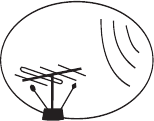
GB 9
• Certain outdoor antennas are pointed at an analogue slave
transmitter. The roof antenna should be pointed at a digital TV
transmitter.
• It is not always advisable to position the antenna as high as
possible. If problems arise, experiment with different antenna
heights. The same applies to analogue transmissions.
2. Indoor or window-mounted antenna
This type of antenna may be enough if the reception conditions
are very good. If an indoor antenna is used, please note the fol-
lowing:
• Use an antenna for UHF channels 21 - 69, such as a directional
antenna.
• The directional antenna should have horizontal polarisation
(preferably rotatable).
• Place the antenna by the window and point it towards the TV
transmitter, if possible.
• An antenna with an amplifier is recommended as it may pro-
vide a stronger signal.
• Attenuation of the TV signal varies according to the building
material. The signal penetrates thick stone or concrete walls
poorly. A window improves reception. However, a wooden
building is no barrier to digital TV signals.
About antennas
Radio and TV signals can be blocked by buildings, mountains and
the terrain. If the receiver is located in a depression in the ground,
behind a mountain or in a concrete building, the quality of recep-
tion may vary considerably.
Because the TV signal is amplified by reflections, reception is
often better than with analogue reception and “ghost” images
can be avoided. Reflection can even be used for reception by
pointing the antenna at a mountain or a high building, providing
that they do not block the transmitter.
As with analogue TV, weather can affect reception. This is the
case particularly at the edge of the reception area for digital trans-
missions.


















